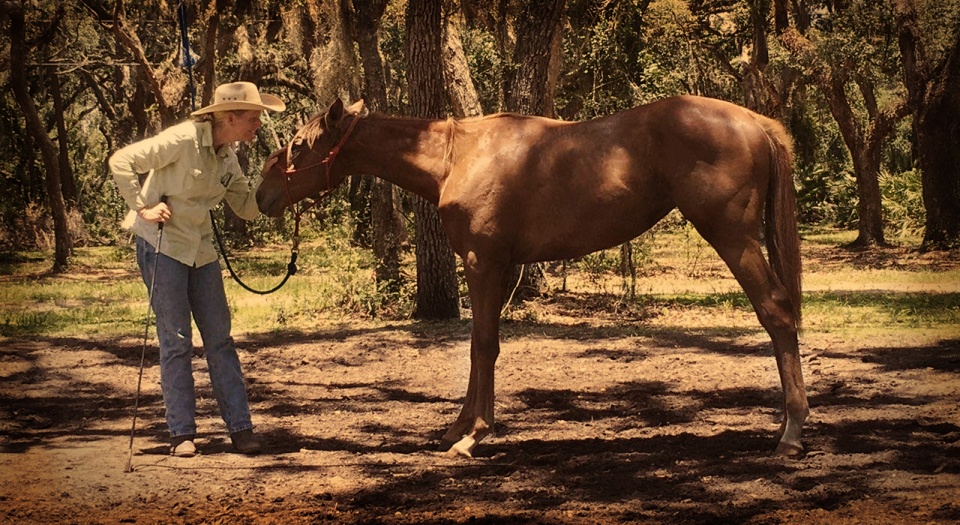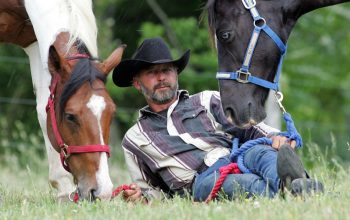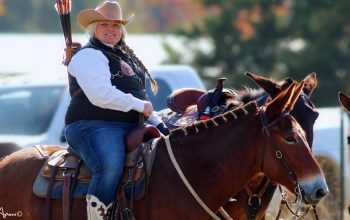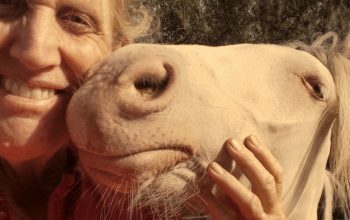 Keys of Success
Keys of Success
By Nancy Slater
One of the keys to success with anything you do in life is having and using the right tools. When training your horse, the most important tool you can use is, believe it or not, your hand. You can guide, hold, and give the horse a gentle, reassuring touch with your hands. When you take hold of a horse, either to lead him or ride, your hands communicate to your partner. Quick, hard hands can scare a horse or make him dull. How you use your hands or any of your training equipment is essential. If you’ve got a rope in your hand, you better have a plan!
Luna came to me as a yearling to learn some manners. She had been imprinted soon after birth and she was loved for her entire first year. Unfortunately, her owners didn’t know how to set boundaries to teach Luna not to push, pull, body slam, and step on their feet! She, in fact, had learned to do anything she wanted and, because of her size, had become dangerous.
 Horses feel a fly on a hair. Sensitivity is something horses are born with, but it doesn’t take long for a person to desensitize a horse to their cues, without even trying. I want a horse soft and eager to respond to my hands, so when I pick up the lead rope or rein, I do it with care. If a horse pushes or pulls on me, I correct the behavior immediately with just enough pressure. I close my hand slowly on the rope and allow the horse to feel the resistance, waiting for them to give to me. I quickly release all pressure when they give. There’s fine line between enough and too much. You can be firm, but be fair. And the release teaches.
Horses feel a fly on a hair. Sensitivity is something horses are born with, but it doesn’t take long for a person to desensitize a horse to their cues, without even trying. I want a horse soft and eager to respond to my hands, so when I pick up the lead rope or rein, I do it with care. If a horse pushes or pulls on me, I correct the behavior immediately with just enough pressure. I close my hand slowly on the rope and allow the horse to feel the resistance, waiting for them to give to me. I quickly release all pressure when they give. There’s fine line between enough and too much. You can be firm, but be fair. And the release teaches.
As a trained professional, I stay current on ethical training techniques and am constantly adding more tools to my ever growing partnership training toolbox. My tools work without force. I use them in sequence; my hands, a rope, a training stick, a round pen, an overhead limb of a live oak tree. The tree is like an invisible round pen that takes the training to the next level. I caution this is advanced work, not to be attempted by a novice.
Since Luna had learned to push, pull, body slam, and mash toes, it was one step forward, 2 steps back for the first week. It was a huge shock to her when I did not allow her dangerous habits. I’m sure it was very confusing to her to be told to change habits she was so accustomed to. I had to carefully explain the new rules to preserve her curiosity, dignity, and try.
Luna was finally ready to be tied high from the oak tree after she was consistently moving off of my pressure. I could control her actions with my training stick. She knew to move her hip to bring me her nose; to come to me when I backed away. Our lines of communication were OPEN. She trusted me. Luna tested the high line rope as I stood closeby watching. She moved around, experimenting with the tree, testing the firmness, steadfastness, the boundaries. She stepped forward to release her own pressure, lowered her head, and began licking and chewing, (signs of understanding and acceptance). When she had finished processing, I gently unclipped her from the tree to hand graze her. She happily munched the green grass as I scratched her belly.
 Teach, control, reinforce, refine are the steps for partnership. With the help of the Patience tree, Luna gives softly to a feeling of pressure from my hands on the lead rope, she respects boundaries, and stands quiet and happy when tied. She doesn’t panic with pressure on her head or anywhere on her body, instead she looks at me and calmly figures out what part to give. She is in the reinforcement stage of development.
Teach, control, reinforce, refine are the steps for partnership. With the help of the Patience tree, Luna gives softly to a feeling of pressure from my hands on the lead rope, she respects boundaries, and stands quiet and happy when tied. She doesn’t panic with pressure on her head or anywhere on her body, instead she looks at me and calmly figures out what part to give. She is in the reinforcement stage of development.
Obstacles, arenas, ropes, bridles, bits, saddles and bareback pads are all tools. There is a purpose and use for each tool, for different stages of development on different horses in different situations. When using a tool, the dignity of the horse must remain intact. That tool should be used only when the horse is ready to understand it and benefit from its use, and never used as punishment. The Patience tree is a helpful tool when used correctly.
Please find a reputable professional, one who encourages you to participate in the training process. Different Horsenalities (horse personalities) need different approaches.
Be safe and savvy on!
———————————————————————————
 For more information:
For more information:




